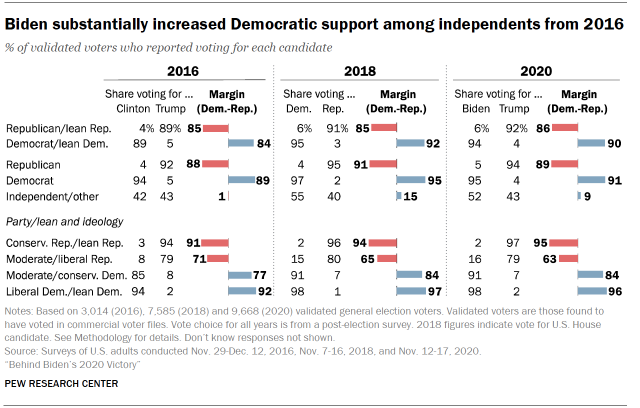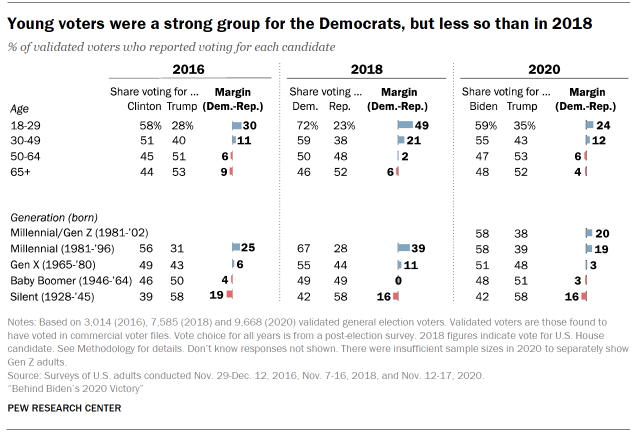One of the most pivotal groups in the 2016 election was White voters without a four-year college degree, who were critical to Trump’s electoral college victory that year (nationally, he won them by a wide 36-point margin in 2016, 64% to 28%). Prior to 2016, differences in candidate preferences by education were typically much smaller than they were that year. In 2020, Trump won 65% of White non-college voters – nearly identical to his 2016 share – even as Biden outperformed Clinton among this group (33% of White non-college voters backed Biden, up from the 28% of this group Clinton won in 2016). At the same time, White voters with a college degree or higher supported Biden by roughly the same margin they had backed Clinton in 2016.
Trump’s stronghold among White men without a four-year college degree loosened somewhat in 2020. While he still won this group by a little more than two-to one (66% to Biden’s 31%), that 35 percentage point gap is notably smaller than the 50-point gap in the 2016 election, when 73% of White men without a college degree supported Trump, compared with 23% who supported Clinton. Meanwhile, White men with a four-year college degree have become increasingly supportive of Democratic candidates, breaking close to evenly in 2016 (47% for Clinton, 44% for Trump) but supporting Biden by a 10-point margin in 2020.
At the same time, Trump’s vote share among White women without a college degree grew slightly between the 2016 and 2020 presidential elections. In 2016, White, non-college women supported Trump by a margin of 56% to 33%. By 2020, Trump’s vote share rose to 64% among this group compared with 35% supporting Biden. Among white women with a college degree, support for Biden was on par with support for Clinton in 2016 (59%-40% in 2020).
Party and ideology
Biden and Trump benefited from similar levels of party loyalty in 2020, with Trump receiving 92% support among Republicans and Republican-leaning independents and Biden getting 94% among Democrats and Democratic leaners. Comparable levels of support for each candidate were seen among Democrats (95% for Biden) and Republicans (94% for Trump), not including leaners. Among independents and those who affiliated with other parties, Biden led Trump by 52%-43%.
Ideological divisions within the parties were also apparent in the vote, with both Trump and Biden doing better among the ideological core of their parties. Trump received the votes of 97% of conservative Republicans and leaners but a smaller majority (79%) of Republicans who describe themselves as moderate or liberal. Biden took 98% of the vote among liberal Democrats and leaners and 91% among those who are moderate or conservative.
Age and generation
A yawning age gap in voter support – a pattern that emerged in the 2004 presidential election for the first time since 1972 – continues to be evident, with voters under 30 favoring Joe Biden by 24 percentage points (Biden 59%, Trump 35%).
Perhaps reflecting the enduring impact of this long-term age gap, voters ages 30 to 49 were also solidly in the Democratic candidate’s camp in 2020, favoring Biden by 12 points (55%-43%), similar to Clinton’s share among this age group. By contrast, older age groups divided fairly evenly between Biden and Trump, a result not too different from 2016.
These patterns also are apparent when the lens is shifted to birth cohorts, or generations – groups of voters who share birth years and perhaps formative political experiences in common, such as the popularity of the president at the time they were first eligible to vote. Voters in the youngest adult generations today – Generation Z (those ages 18 to 23 in 2020) and the Millennial generation (ages 24 to 39 in 2020) – favored Biden over Trump by a margin of 20 percentage points, though Trump gained 8 points among Millennials compared with his 2016 performance. Generation Xers, those ages 40 to 55 in 2020, divided relatively evenly (51% to 48%), as did Baby Boomers. Only among members of the Silent Generation, ages 75 to 92 in 2020, was Trump clearly favored (by 58%-42%). Notably, Boomers and Silents (and the very small number of voters from the Greatest Generation) made up less than half of the electorate in 2020 (44%), compared with just over half in both 2016 and 2018.
Geography
The political split between America’s rural areas and its suburban and urban locales remained substantial in 2020. Biden did considerably better among suburban voters in 2020 than Clinton did in 2016 (54% for Biden, 45% for Clinton). By contrast, Trump garnered the support of 65% of rural voters, including 71% of White rural voters; the latter represented an increase over the 62% he received among this group in 2016. Biden received a solid majority of votes among urban residents (66% overall), but Trump gained among urbanites relative to his performance in 2016 (33% in 2020, 24% in 2016).
Editor's Note: NPR Transcripts
More Articles
- Journalist’s Resource* Election Beat 2020: The Mysterious Voter Registration Deadline
- By Nearly a 2-1 Margin, Parents Prefer to Wait to Open Schools to Minimize COVID Risk, with Parents of Color Especially Worried Either Way
- Poll: Democrats Say They Are Hearing Enough From Presidential Candidates About Medicare-for-All and Expanding Coverage, But Want Them to Talk More about Health Costs and Women’s Health Care
- Jo Freeman's Democratic Convention Diary: Bernie Sanders Supporters, More Sad Than Celebratory, More Angry Than Uplifted
- Could Your Political Beliefs and Party Affiliation Influence How Long You Live?
- Main-Street Republicans, Hard-Pressed Democrats, Bystanders and Post Moderns: The Political Typology








